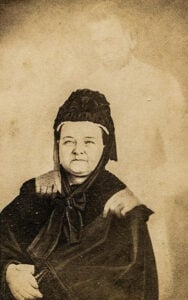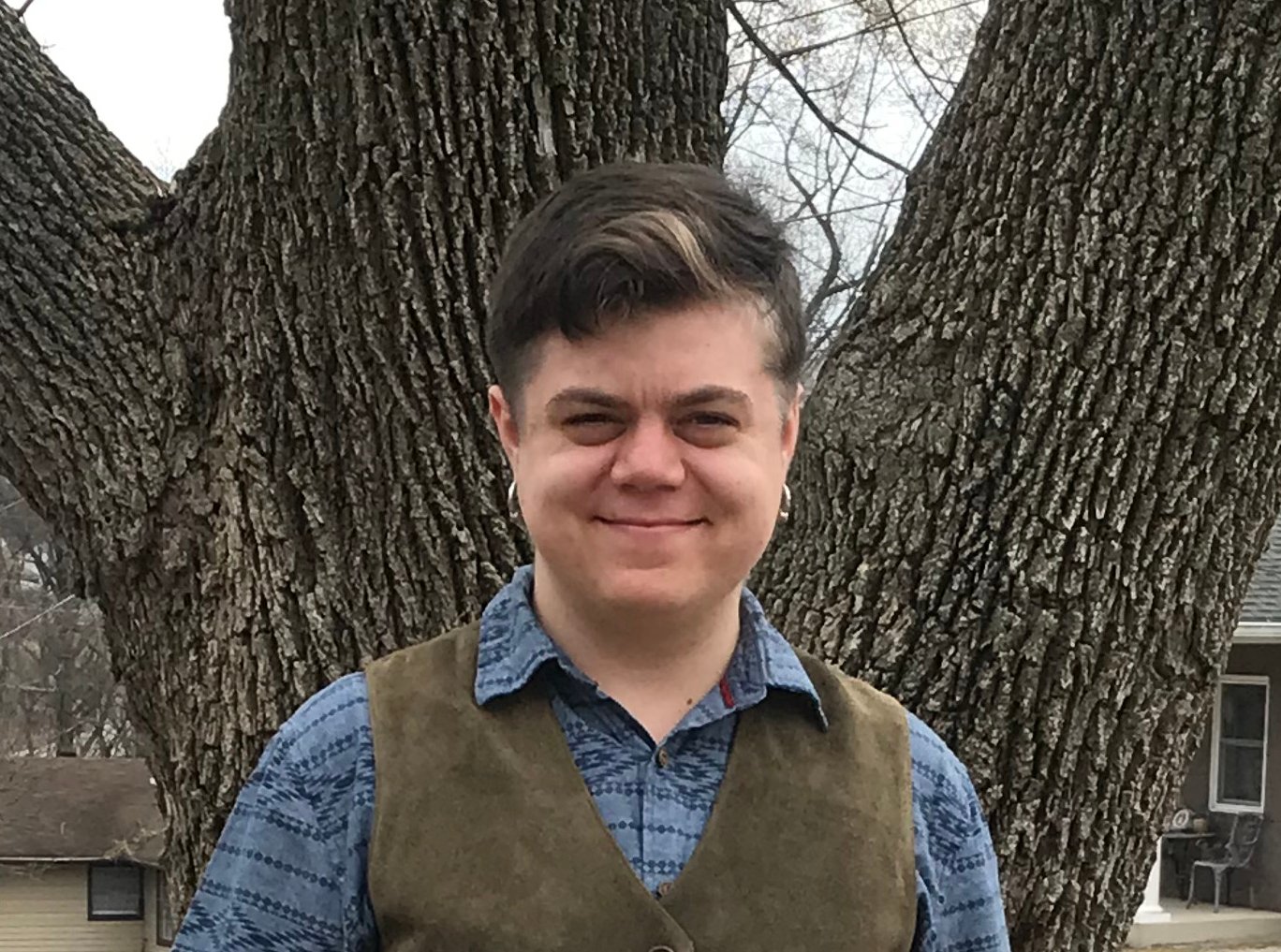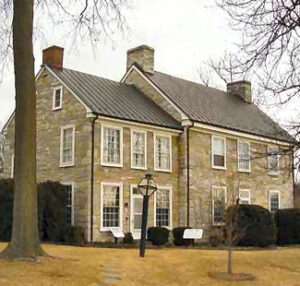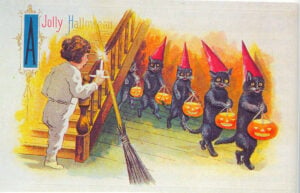 Mary Todd Lincoln with the ghost of her husband Abraham Lincoln behind her, circa 1872. Photo by William H Mumler.
Mary Todd Lincoln with the ghost of her husband Abraham Lincoln behind her, circa 1872. Photo by William H Mumler.
Thank you to everyone who answered our call for submissions! I had so much fun going through the treasure trove of strange, poignant, and even funny stories you sent in. Ghosts abound in the history and popular lore of the United States—and as the selection of highlights I’ll be sharing illustrates, our ghosts have everything to do with our family histories, and our collective past as a country.
Modern ghost stories owe many of their common tropes to Spiritualism —a popular movement which arose during the mid-19th century in the U.S. and England, centered around the belief that the spirits of the dead can be communicated with by the living. Most accounts of the beginnings of Spiritualism point to the 1848 incident of Maggie and Kate Fox: teenage sisters from Hydesville, NY, who claimed they could communicate with a ghost in their home through a series of mysterious “rapping” sounds, and became known as the first Spiritualist mediums. Well-known figures of the 19th century, such as Mary Todd Lincoln and Sir Arthur Conan Doyle, were staunch believers in Spiritualism, and while popularity has declined, Spiritualist ideas remain embedded in our culture today.
Given this context, I was thrilled to receive a submission from genealogist Jerry Carbone of Brattleboro, VT, about a Spiritualist artifact he discovered in his research: letters written to a man named Edward Edwards from his deceased wives and relatives , as transcribed by mediums. Whether these letters represent genuine contact with the beyond or not, they clearly seem to have brought their recipient comfort. They contain reassurances that he is being watched over and guided, that his two deceased wives get along with each other, and even that his family members have come around to his Spiritualist beliefs, as in this message from Edwards’ brother:
“My Dear Brother, We are nearly all over here you are not coming to a lonely place/ Your two wifes seem to be so happy together. I do not know which will be the one who will be chosen to walk through spirit life with, but—I do know—they both care for you. Father laughs about the old ideas of religion.”
Many historians have theorized that Spiritualism rose in popularity in response to the hardships faced by Americans during the 19th century—the massive losses of the Civil War and the lingering horrors of slavery, in particular, leaving an indelible mark on American families. In a time when death likely seemed to be all around, it’s understandable that the idea of communicating with lost family members might give many people comfort and hope. Our next story, concerning a ghost with musical tendencies, reflects the tragedy of this era:
“When my maternal grandmother was a little girl, she and her family moved into a home that was already furnished, complete with a baby grand piano in the parlor. Late at night, the family would hear the piano playing softly—always the same tune. When her father moved the piano to the basement, the ghost began to bang that same tune LOUDLY each night, until it was returned to its place. The family learned later that the daughter of the house’s previous owner had lost her fiancé on the day of her wedding—a Confederate officer, killed by Union snipers on his way to the house. The bride-to-be was playing the piano when the news of his death arrived. She died soon after of a broken heart.” – Vickey LB, Virgina
And while many of these lingering spirits are tied to houses and domestic spheres, this next tale comes directly from the battlefield:
“Once on a visit to Gettysburg, I was walking with three others on Little Roundtop, heading towards the marker for the 20th Maine. There was a cool, steady evening breeze, and nobody else was around, when I suddenly smelled pipe tobacco, as strong as if the person next to me had been puffing away. When I commented on it, the others with me froze as well—we all smelled it. Then just as quickly, it ended.” – Bill Hallett, Kingston, NH
Another submission recalls the painful experiences of Black Americans who fled enslavement:
“I grew up in an old farmhouse in Topeka, Kansas rumored to have been part of the Underground Railroad. When my Dad converted the attic into my bedroom, we discovered a false ceiling that led to a second attic, large enough to accommodate several people with space to move around. I often felt that I was not alone in this room. Three different times, I saw a young Black man of about 20, wearing a blue shirt and worn overalls with one strap falling from his shoulder. I had an overwhelming sense that he was lonely. My mother, siblings, and daughter have all seen this ghost at one time or another. I believe he was a runaway slave who died in this house before he reached freedom. I often wonder who he was, and would love to know his story.” – Becky Stephens, Texas
Not every unexplained vision is interpreted as a spirit, as in this story of a community brought together by a miracle:
“Francis Marion Williams held the annual revival of Sharp Mountain Church in Cherokee County, Georgia in late September of 1873. He "was about to line out the hymn," when a bright light suddenly appeared in the log church, emitting various sounds of rushing water, angel voices, and music to those present. The congregation were in such awe that they then refused to leave the log church except when absolutely necessary. People literally came from miles around, and from other counties, to witness this miracle, which continued for weeks. Williams was aided by his colleague reverends—including Elias Allred, my several times double-great uncle—to cut a hole in the frozen Etowah River and baptize the record-breaking seventy-three converts. The congregation was badly divided by the Civil War, and grudges were murderous, but what they perceived as a miracle brought them together.” – Robert S. Davis, Blountsville, AL
And while many ghost stories naturally revolve around hardship and tragedy, I was charmed by this story of a ghost whose unusual life story looms larger than the circumstances of her death:
“Family research took us to visit Abrams Delight in Winchester, VA, where Mary Hollingsworth is the resident ghost. She dressed as a man to earn money for her family, and became entangled in a relationship with the bosses' daughter—and was sued by her boss for not marrying her! People have reported seeing a tall person in work clothes who disappears when they look back.” –Laurie Sisson, Alexandria, VA
Of course, plenty stories of unexplained phenomena date to eras long before the rise of Spiritualism in popular imagination, as in this next example from early American history:
“While serving in the Revolutionary War, my daughter-in-law’s ancestor James Gignilliat rented Ticton Hall and moved in his wife, mother and children, then returned to his post. A few days later, his family reported sounds of footsteps ascending stairs, and had their bed covers removed in the night without waking them. James took leave to come home and found that the stories were true. Sword in hand, he stood on the staircase landing as the sound of footsteps approached him. He thrust, but only struck air, and the footsteps continued past him. He moved his family to outbuildings until after the harvest, when they returned home.” – Pam Senkler, Naples, FL
Sometimes reality is strange enough, even without unexplained visions. This story concerns a less ghostly kind of revival:
“I heard this legend from my mother, who grew up in Cambridge, MD. About 1740, Hannah (Martin) Maynadier, wife of the minister of St. Peter’s Parish in Talbot County, Maryland, became ill and died. Rumors circulated that she was buried with a valuable ring. The night of her burial, two thieves dug up her coffin and, unable to remove the ring from her finger, decided to cut her finger off. When the blood started to flow, Hannah woke and sat up, scaring off the thieves. She climbed out of her coffin and made her way to the manse, where she collapsed on the doorstep and was found by her husband. She lived for several more years after. Oddly, neither her supposed nor actual death are listed in parish records.” – Ginny Blair, Augusta, GA
Another appropriately Halloween-themed tale comes from Philip Grover of Concord, CA, whose ancestor’s strange behavior was written about in a letter to the editor of the Salem Register in 1846:
“The Grover family, from which the street [in Beverly] takes its name, were among the earliest settlers [in the area]; and altho’ the name is extinct here, yet there are many descendants in other parts of Beverly. Tradition says that one of the last of the name, for some deed of darkness he had done, was doomed to be haunted by troops of black cats, whom he was obliged to exorcise by spending most of his nights in psalm singing, which his peculiar style enabled him to employ to such advantage as to silence and subdue all the caterwauling of his sabled tormentors. The last that was seen of these supposed agents of the other world was upon the night of his decease, when they completely covered his coffin; and upon being disturbed, all made their exit up the chimney, bearing as was supposed, the spirit of their victim with them."
If spooky is what you’re after, no ghost tour would be complete without a haunted hotel. The next story illustrates how the tragedies we experience while alive can connect us back to the tragedies of those who came before:
My great-grandmother’s wedding night in 1894 was not the happiest. She had been forced to marry someone she didn’t truly love, as the man she was in love with was already married. Briefly alone in the hotel room that night, she turned to the mirror and saw a young man standing before it. As she watched in horror, he took his straight razor and slashed his throat. Later, they learned that she was not the only guest to have seen this ghost, who killed himself years ago after his bride’s sudden death on the night of his own marriage.” –Catherine Garcia, Santa Clarita, CA
I’ll leave you for now with an amusing tale which serves as a reminder that not every shape in the darkness means danger:
“About the year 1830, over the course of a few nights, several people in a small Pennsylvania town saw a groaning white shape in the cemetery. Everyone became afraid to go there. My 2nd great-grandfather dared to go into the cemetery, and found out that it was an old blind white sow who had entered through a broken fence, and could not find her way out.” –Mary MacGinitie Ferm, Bainbridge Island, WA
Thank you again to everybody who took the time to write in! If your story wasn’t included, don’t despair yet. I’ll be back next week with another batch—this time, all about the family ghosts who haunt our present day. Until then, enjoy these last days of October, and take some time to remember the ancestors whose stories linger in your own life.
Share this:

About Thomas Grebenchick
Thomas is responsible for managing and updating existing web content, creating new content, and assisting in digital communications and strategy. Originally from Massachusetts, he holds a B.A. in English from Brandeis University, and has experience in copywriting, web and digital design, and social media marketing.View all posts by Thomas Grebenchick →

